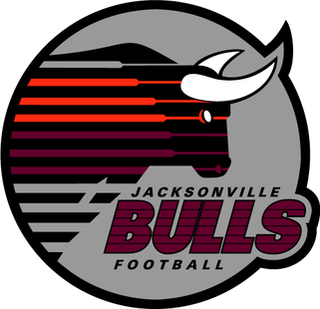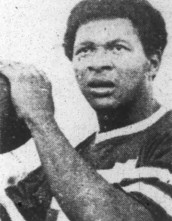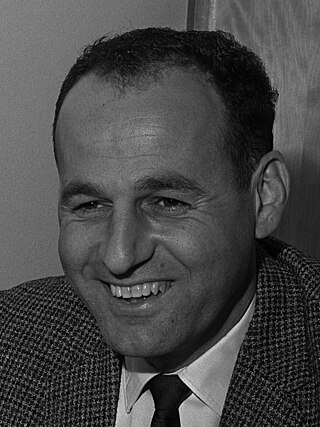
The United States Football League (USFL) was a professional American football league that played for three seasons, 1983 through 1985. The league played a spring/summer schedule in each of its active seasons. The 1986 season was scheduled to be played in the autumn/winter, directly competing against the long-established National Football League (NFL). However, the USFL ceased operations before that season was scheduled to begin.
The Philadelphia / Baltimore Stars were a professional American football team which played in the United States Football League (USFL) in the mid-1980s. Owned by real-estate magnate Myles Tanenbaum, they were the short-lived league's dominant team, playing in all three championship games and winning the latter two. They played their first two seasons in Philadelphia as the Philadelphia Stars before relocating to Baltimore, where they played as the Baltimore Stars for the USFL's final season. Coached by Jim Mora, the Stars won a league-best 41 regular season games and 7 playoff games.
The Orlando Renegades were a professional American football team that played in Orlando, Florida, in the United States Football League (USFL) for a single season in 1985. Before its season in Orlando, the franchise played in Washington, D.C., as the Washington Federals for two seasons, in 1983 and 1984.
The Arizona Wranglers were a professional American football team in the United States Football League that, name-wise, existed from late 1982 to mid-1985. They played at Sun Devil Stadium on the campus of Arizona State University in Tempe, a suburb of Phoenix.
The Arizona Outlaws were a professional American football team that played in the United States Football League in the mid-1980s. They were owned by Fresno banker and real estate magnate William Tatham Sr., who had briefly owned the Portland Thunder of the World Football League.
The Oakland Invaders were a professional American football team that played in the United States Football League (USFL) from 1983 through 1985. Based in Oakland, California, they played at the Oakland–Alameda County Coliseum.
The New Jersey Generals were a franchise of the United States Football League (USFL) established in 1982 to begin play in the spring and summer of 1983. The team played three seasons from 1983 to 1985, winning 31 regular season games and losing 25 while going 0–2 in postseason competition. Home games were played at Giants Stadium in East Rutherford, New Jersey, which was called The Meadowlands for Generals games.
The Pittsburgh Maulers were a team that competed in the 1984 season of the United States Football League. Their most prominent player was first pick overall in the 1984 USFL Draft, running back Mike Rozier of Nebraska, who won the Heisman Trophy, collegiate football's most prestigious individual award.

The Tampa Bay Bandits were a professional American football team in the United States Football League (USFL) which was based in Tampa, Florida. The Bandits were a charter member of the USFL and was the only franchise to have the same principal owner, head coach, and home field during the league's three seasons of play (1983–1985). The Bandits were one of the most successful teams in the short-lived spring football league both on the field and at the ticket booth. Spurrier's "Bandit Ball" offense led them to three winning seasons and two playoff appearances, and their exciting brand of play combined with innovative local marketing helped the Bandits lead the league in attendance. However, the franchise folded along with the rest of the USFL when the league suspended play after the 1985 season.
The Memphis Showboats were an American football franchise in the United States Football League. They entered the league in its expansion in 1984 and made the 1985 playoffs, losing in the semifinal round to the Oakland Invaders. Perhaps the most prominent players on the Showboats' roster during their two seasons of existence were future Pro Football Hall of Fame member Reggie White and future professional wrestler "The Total Package" Lex Luger.

The Jacksonville Bulls were a professional American football team based in Jacksonville, Florida. They were members of the United States Football League (USFL) during its final two seasons, 1984 and 1985. They played their home games in the Gator Bowl in Jacksonville.
The Denver Gold was a franchise in the United States Football League, an attempt to establish a second major professional football league in the United States, playing a springtime season, from 1983 to 1985. The Gold played their home games at Mile High Stadium in Denver, Colorado; and were co-tenants in the spring with the Triple-A Denver Zephyrs baseball team.
Marcus L. Dupree is a former American football player. He was born and grew up in Philadelphia, Mississippi, where his playing in high school attracted national attention. A highly touted and sought-after college football recruit, he played at Oklahoma, where he was named Football News Freshman of the Year, second-team All-American and Big Eight Conference Newcomer of the Year. He left in the middle of his sophomore season and briefly attended the University of Southern Mississippi. Marcus played spring football for the Golden Eagles and finished college at the university.

John Booker Walton is a former American football player and coach. He played professionally as a quarterback in the Continental Football League (CFL), World Football League (WFL), National Football League (NFL), and United States Football League (USFL). Walton played college football at Elizabeth City State University. He served two stints at the head football coach at Elizabeth City State, from 1980 to 1982 and 1989 to 1990, compiling a record of 25–24–2.

Richard P. Coury was an American football coach. He served as head football coach at California State University, Fullerton from 1970 to 1971, compiling a record of 13–8–1. Coury was also the head coach for the Portland Storm of the World Football League (WFL) in 1974 compiling a record of 7–12–1, and the Boston/New Orleans/Portland Breakers of the United States Football League (USFL) from 1983 to 1985. He was named the USFL coach of the year in 1983 and compiled an overall record of 25–29–0.

The 1984 USFL season was the second season of the United States Football League.
Bennett Lee Needham is a former American football linebacker. He played college football for the University of Michigan from 1978 to 1979 and in 1981 and professional football in the United States Football League (USFL) for the Boston/New Orleans/Portland Breakers from 1983 to 1985. He was selected by the Sporting News as a first-team USFL All-League player in 1983.

Bill Winters is an American former professional football offensive lineman who played in the National Football League (NFL), Canadian Football League (CFL), American Football Association (AFA), and United States Football League (USFL) for eight seasons during the 1970s and 1980s. He played college football for Princeton University, and thereafter he played professionally for the Washington Redskins and New York Giants of the NFL, the Montreal Alouettes and BC Lions of the CFL, the Orlando Americans and Carolina Storm of the AFA, and the Tampa Bay Bandits, San Antonio Gunslingers, and Portland Breakers of the USFL.

The team started out in 1983 as the Boston Breakers, owned by Boston businessman George Matthews and former New England Patriots wide receiver Randy Vataha. However, finding a stadium proved difficult. The lack of a professional-quality stadium had stymied previous attempts at pro football in Boston before the Patriots arrived in 1960.

From the beginning, USFL founder David Dixon placed a premium on putting a team in the New York area. Initially, Donald Trump was tapped to own the team. However, he backed out after paying an initial installment on the franchise fee, hoping instead to buy the struggling Baltimore Colts of the NFL. Needing a credible owner with the means to front a team in the nation's biggest market, Dixon persuaded Oklahoma oil magnate J. Walter Duncan to step in. Duncan had originally been slated to own the USFL's Chicago franchise, as he'd grown up in Chicago. However, he readily agreed to shift to New York.








